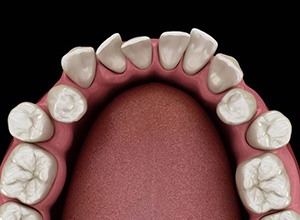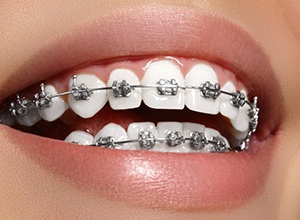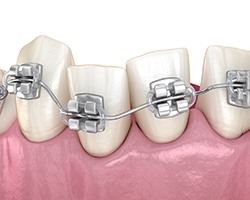Traditional Braces – Enfield, CT
The Tried-and-True Path to Straighter Teeth
In the past couple of decades, a number of innovative orthodontic treatments have come onto the market. However, while such products can be effective and convenient, they have not caused traditional braces in Enfield to become obsolete. In fact, braces remain one of the best ways to address dental misalignment. Read on below to learn more about this reliable treatment, and contact us when you are ready to schedule an orthodontic consultation.
Why Choose Four Town Dental Care for Traditional Braces?
- Highly Skilled Team of Experts
- Comfortable Environment
- Flexible Payment Options
How Do Traditional Braces Work?
 To place braces on your teeth, your dentist in Enfield will bond brackets onto them. The brackets will be used to hold an arch wire in place. As the wire is adjusted at periodic appointments (every 6 – 8 weeks or so), the braces will apply pressure to the teeth and gradually move them into their proper positions. Total treatment time can vary from case to case, but on average, braces can take anywhere from 18 to 36 months to finish their work.
To place braces on your teeth, your dentist in Enfield will bond brackets onto them. The brackets will be used to hold an arch wire in place. As the wire is adjusted at periodic appointments (every 6 – 8 weeks or so), the braces will apply pressure to the teeth and gradually move them into their proper positions. Total treatment time can vary from case to case, but on average, braces can take anywhere from 18 to 36 months to finish their work.
What Orthodontic Issues Can Braces Fix?
 Braces are a versatile treatment that is capable of correcting most orthodontic issues, from the mild to the severe. During your consultation, our team will determine if they are a fit for your case. Here are some examples of problems that braces are often used to address:
Braces are a versatile treatment that is capable of correcting most orthodontic issues, from the mild to the severe. During your consultation, our team will determine if they are a fit for your case. Here are some examples of problems that braces are often used to address:
Bite Misalignment
A misaligned bite, also known as a malocclusion, can include issues like overbite, underbite, open bite, and cross bite. Since a bad bite can lead to TMJ dysfunction, difficulty chewing, and other issues, correcting it is important. Braces, along with accessories, such as elastics, are often able to bring a patient’s bite into harmony, allowing the upper and lower teeth to work together seamlessly.
Crowded & Crooked Teeth
Crooked and crowded teeth are prone to trap food between them, increasing your risk of decay, bad breath, and gum disease. Fortunately, braces can move the teeth apart so each one has the space it needs to thrive. In some cases, one or more extractions are necessary to ensure that braces can effectively do their job.
Gapped Teeth
Many people believe that extra space between the teeth is unsightly. Not only that, having too much room between the teeth can leave the gums vulnerable to irritation and damage. Braces are usually able to move the teeth closer together so they function better and look more appealing.
Caring for Your Braces
 Here are some tips to help you care for your teeth and braces throughout your treatment:
Here are some tips to help you care for your teeth and braces throughout your treatment:
- Maintain a clean mouth. You may have to use special instruments to clean around your braces. You may also have to brush more often than you are used to.
- Adjust your diet. You should avoid any foods that could damage your braces or your teeth. For example, you should steer clear of foods that are extremely sticky, chewy, or hard.
- Attend all appointments as recommended. Not only will have to visit your orthodontist so they can maintain your braces, but you should also keep up with regular preventive appointments with your general dentist.
Understanding the Cost of Traditional Braces

The cost of traditional braces varies from patient to patient; many factors can affect the cost of treatment. When you come in for your consultation, we will be able to provide an estimate. We will also help you understand provisions you can use to make your treatment easier to afford, such as financing.
Factors That Affect the Cost of Traditional Braces

Some factors that can have a bearing on the cost of traditional braces include:
- The severity of your dental misalignment. More severe dental alignment tends to take longer to correct, require more dental visits, and necessitate the use of more accessories than simpler cases. Therefore, severe and complex cases come with higher prices.
- A patient’s age. Often, orthodontic treatment for adults takes a bit longer and costs a bit more because their tooth movements are slower than what occurs in younger patients.
- Compliance with treatment instructions. If you accidentally break your braces or fail to wear rubber bands as instructed, you could extend your treatment timeline and face increased fees.
Professional Braces vs. “DIY” Braces: Which Costs More?

You might have seen some so-called “hacks” on social media that show you how to straighten your teeth with common household products, like rubber bands, paper clips, superglue, and dental floss. While it might be appealing to try to save money by creating makeshift braces, extreme caution is in order.
Often, individuals without an in-depth knowledge of dental treatment accidentally end up worsening their misalignment or damaging their oral tissues when they try DIY methods. Then, they have to spend a large amount of money to correct their mistakes. It is generally wiser and more affordable to seek professional care right from the outset.
Does Dental Insurance Cover Braces?

Some dental insurance plans limit their orthodontic coverage to minors (patients under the age of 18 or 12), while others extend coverage to adults. Some plans offer no orthodontic benefits whatsoever. You will have to check your policy to see how it applies. Our team can help you navigate your benefits and file your claims. If your plan covers braces, it might reduce your out-of-pocket costs by 50%, up to the amount of your policy’s lifetime orthodontic maximum.
Options for Making Braces Affordable

Here are a few useful provisions that might make it easier to afford your braces:
- Most patients are eligible for low-interest financing through CareCredit, a third-party lender. Our team can guide you through the application process.
- Essential Dental Plan. This discount plan provides reduced fees on most of the services available at Four Town Dental Care.
Would you like to learn more about traditional braces and their cost? Get in touch with our team to schedule your consultation. We look forward to serving you!
Traditional Braces FAQs

Traditional metal braces have the potential to do wonders for your dental alignment. However, they do represent a significant commitment of both time and money. You may want to learn as much about them as possible before you move forward. To help you in your quest to gather information, we have compiled the following list of FAQs, along with easy-to-understand answers. If you do not see your specific questions addressed, call our team so we can directly share our knowledge.
Am I Too Old to Get Braces?
Many people are under the impression that metal braces are exclusively for children and adolescents. That simply is not true. In fact, there is no upper age limit for braces. Many orthodontic patients are well into adulthood.
Of course, getting braces when you are a bit older may affect some aspects of your treatment. For example, adult teeth tend to move more slowly than those of younger individuals. Therefore, it might take longer for your braces to produce their final results, and the overall cost of your care may be higher. Also, while insurance sometimes covers braces for minors, it is less likely to do so for adults.
What Happens After You Get Your Braces Off?
Teeth have a sort of memory. After your braces are removed, therefore, your teeth will naturally want to revert to their former positions. To prevent this from happening, you will need to wear a retainer.
If your retainer is removable, you will have to remember to wear it for 20 – 22 hours each day. As your teeth solidify into their new positions, you may be able to progress to wearing your retainer for just a few nights each week.
How Long Do Traditional Braces Take?
Braces usually take 18 – 36 months to complete their work. Granted, that is a large range. Exactly how long your treatment will require depends on a number of factors, such as the severity of your dental misalignment, your age, and more. During your consultation, we will be able to estimate how long you will need to wear braces.
We will also advise you on things you can do to avoid unnecessary delays. For example, you should take excellent care of both your braces and your teeth. You should also use all accessories as directed by our team.
Do Traditional Braces Hurt?
Traditional braces are known to cause some soreness in both the teeth and gums. The strong pressure they apply to the teeth is necessary, but it can be a source of discomfort. Plus, some patients find that the metal brackets and wires are irritating to their oral tissues.
Our team will coach you on how you can cope with the discomfort of braces. For example, we might advise you to adjust your eating and drinking habits, take over-the-counter pain relievers, and use orthodontic wax to cover any part of your braces that is irritating you.
If your braces ever cause extreme discomfort, give our team a call. We will do all we can to remedy the situation.
